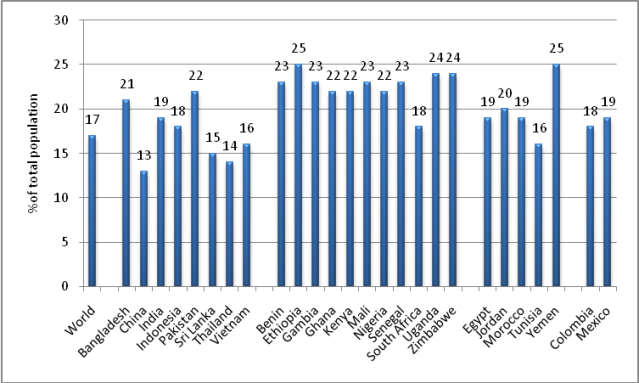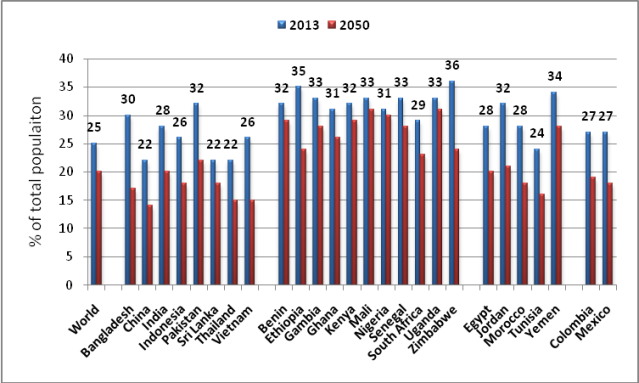Inter-Governmental Alliance, Partners in Population and Development (PPD) is Urging Its 26 Member Countries to Invest More in Young Population for Sustainable Development
“Investing in Young People” is the theme of the World Population Day this year. Partners in Population and Development (PPD) is taking this opportunity to reflect on the young population of its 26 member countries, the opportunities associated with them and to urge the governments of its member countries to further invest in this population group to ensure sustainable development.
PPD is a southern-led, southern-run Inter-governmental organization of 26 developing countries representing 58% of world population (http://www.partners-popdev.org/). PPD was established in 1994 following the recommendation of the International Conference on Population and Development (ICPD) Program of Action with the mandate to promote South-South Cooperation on Reproductive Health, Population and Development in developing countries. The organization is a permanent observer at the United Nations; the secretariat is located in Dhaka, Bangladesh, an African Regional Office in Kampala, Uganda, a program office in China and UN liaison offices in New York and Geneva. PPD is celebrating its 20th anniversary this year.
Demographic transitions in the past decades have led to the largest generation of young people (aged 10-24 years) in the world today, comprising adolescents (aged 10-19 years) and youth (aged 15-24 years). The adolescents aged 10-19 years stood about 1.2 billion in 2012, constituting 17% of the total world population. When about 90% of them live in developing countries, over 61% live in 26 member countries of PPD. The proportion of adolescents ranged from highest 25% in Ethiopia and Yemen to lowest 13% in China in 2012 in 26 PPD member countries (Fig. 1).
Fig 1. Proportions of adolescents (10-19 yrs) in PPD member countries, 2012
Young people aged 10-24 years were about 1.8 billion in 2013, accounting for 25% of the total world population. Around 88% of them live in developing countries and 26 member countries of PPD is the home of nearly 62% of the world’s young population. In the member countries of PPD, the proportion of young population ranged from highest 36% in Zimbabwe to lowest 22% in China, Sri Lanka and Thailand in 2013 (Fig 2). The proportions of these young people will decrease substantially globally from 25% in 2013 to 20% in 2050. Marked decrease in proportions of young population would be observed in all member countries of PPD by 2050, particularly in the Asia-pacific, MENA, Latin America regions, and in Ethiopia and Zimbabwe in Sub-Saharan Africa region.
Fig 2. Trends of young population (10-24 yrs) in PPD member countries, 2013-2050
The Governments’ of the world nations made commitments to improve the lives of young people at both international and regional levels including at the ICPD in 1994, World Program of Action for Youth in 1995, and at legally binding conventions like the Convention on the Rights of the Child in 1990. All these events recognized the importance of young people’s role in poverty reduction and in over all national development process.
However, currently almost half of all young people live on less than USD 2 a day, about 71 million adolescents were out of school, majority of them are girls. Even, despite near-universal commitment to end child marriage, one in three adolescent girls is married before age 18 in the developing countries. Nine out of 10 adolescent pregnancies take place in the context of early marriage. Every year, 16 million adolescent girls give birth and about 70,000 adolescents die of causes related to pregnancy and childbirth in the developing countries. Furthermore, about 8.7 million young women aged 15-24 years resort to unsafe abortions each year and 15% of all these unsafe abortions are among adolescent girls in developing countries. In addition to that, young people aged 15 to 24 accounts for 41% of all new HIV infections, with 2,400 young people infected every day. Young women are particularly at risk, when infection rates are twice as high as young men, representing about 60% of young people in the world living with HIV and AIDS.
Nevertheless, discriminatory laws, unsafe practices, barriers to access and attitudes continue to keep these young people and adolescents from accessing sexual and reproductive health services, including contraception and realizing their reproductive rights. When Sexual and Reproductive Health Rights (SRHR) are fundamental human rights, and adolescents and youths are major rights holders, they remain a huge underserved population group in most developing countries. This situation call for Governments to invest additional resources in adolescent and youth development and to pay explicit attention to their Sexual and Reproductive Health and Rights, education, employment, gender inequalities, in order to provide targeted policies, programs and services.
Evidence shows that investments in adolescents and youth yield positive outcomes for the rest of their lives; with social, economic, demographic and environmental multiplier benefits. In the case of investing in adolescents girls and young women, the positive effects even go beyond employment and productivity. Empowerment of girls and women lead to better maternal health, lower child mortality and an increase in reinvestment to household and communities.
From a population dynamics perspective; the numbers of young people in the developing countries compared to other age groups demand concrete investment. In PPD Member countries, large proportions of youth and adolescents in the population structure are offering windows of opportunity for them. This window of opportunity is termed as the Demographic Dividend, which is defined as the potential economic benefit offered by changes in the age structure of the population during the demographic transition, when there is an increase in working age population (which includes youths) and an associated decline in the dependent age population. The Demographic Dividend does not happen automatically, it depends both on creation, investment and capitalization of the opportunity through adopting specific policies and creating favorable environments dealing with education, public health, and those that promote labor market flexibility and provide incentives for investment and savings.
In the ICPD beyond 2014 and Post 2015 consultations, the young population group emerged as the key population age group which will have a major impact on the Governments’ policies and development strategies for achieving the Sustainable Development Goals (SDGs). In the zero draft of the proposed goals and targets of the SDGs for the Post 2015 Development Agenda, due attention has been given for youths on universal access to reproductive health, access to equitable and inclusive education and training, employment opportunities, poverty reduction, empowerment of women and girls, addressing gender inequalities etc.
With this background, PPD is urging its member countries’ Governments to make adequate investment for adolescents and youths, specifically for their quality education, training, employment, and SRHR services that are free of charge, confidential, accessible and suitable for adolescent girls, boys and young people. The services should include full range of safe, effective, and affordable methods of modern contraception, including access to safe and legal abortion and post abortion services. Also, to make provision for young people to have access to comprehensive sexuality education and youth friendly sexual and reproductive health information and services, which should address barriers e.g. discrimination, social stigma and lack of confidentiality. The Governments also need to adopt rights-based and gender-responsive approaches to maximize opportunities for gainful employment, especially for women, strengthen migration policies, specifically to ensure Sexual Reproductive Health Rights and protection of the rights of the out-migrants youth population.
PPD is planning to offer a platform for dialogues on increasing investment in young population for sustainable developing in developing countries during its 11th International Inter-ministerial Conference to be held in November 2014. PPD also wish to facilitate the continued discussions on updating policies and strategies through effective use of evidence-based population analysis, and its impacts on sustainable development by expanding access to gender-sensitive, life skills-based sexual and reproductive health education, promoting a core package of sexual and reproductive health services integrated with HIV/AIDS in its member countries.
References:
- International Conference on Population and Development – ICPD – Programme of Action
https://www.unfpa.org/webdav/site/global/shared/documents/publications/2004/icpd_eng.pdf - United Nations, Department of Economic and Social Affairs. Population Division, Population Estimates and Projection Section.
http://esa.un.org/unpd/wpp/unpp/panel_indicators.htm - World Youth’s Data Sheet 2013, Population Reference Bureau (PRB). http://www.prb.org/pdf13/youth-data-sheet-2013.pdf
- The State of the World’s Children 2014 in Numbers
http://www.unicef.org/sowc2014/numbers/documents/english/SOWC2014_In%20Numbers_28%20Jan.pdf - Policy Brief: Priorities for the Post-2015 Development Agenda.
http://www.who.int/pmnch/media/news/2012/policybrief_post2015.pdf - Policy Recommendations for the ICPD Beyond 2014: Sexual and Reproductive Health & Rights for All.
http://www.icpdtaskforce.org/pdf/Beyond-2014/policy-recommendations-for-the-ICPD-beyond-2014.pdf - Population Dynamics in the Post-2015 Development Agenda. Report of the Global Thematic Consultation on Population Dynamics.
http://unfpa.org/webdav/site/global/shared/documents/publications/2014/Population%20Dynamics%20in%20Post-2015%20FINAL.pdf - Population Dynamics Realizing the Future We Want for All: The Post–‐2015 Development Agenda. Global Thematic Consultation. Population Dynamics in the context of the post-215 development agenda, February 2013
- Opening remarks of Dr. Babatunde Osotimehin, UNFPA Executive Director at the Opening of 47th Session of the Commission on Population and Development, 7 April 2014,
http://www.unfpa.org/public/home/news/pid/17041 - Zero Draft of the Proposed Goals and Targets on Sustainable Development for the Post2015 Development Agenda.
http://sustainabledevelopment.un.org/focussdgs.html


